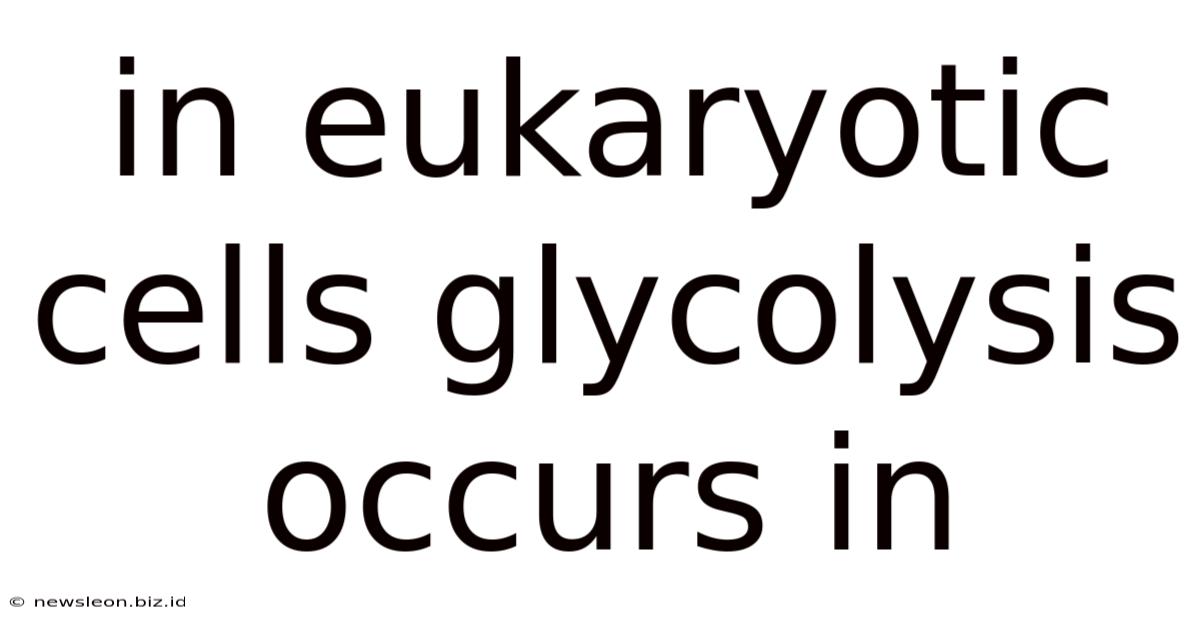In Eukaryotic Cells Glycolysis Occurs In
News Leon
May 03, 2025 · 5 min read

Table of Contents
In Eukaryotic Cells, Glycolysis Occurs In… The Cytoplasm! A Deep Dive into Cellular Respiration's First Step
Glycolysis, the foundational process of cellular respiration, is a fascinating metabolic pathway crucial for life as we know it. Understanding where this process unfolds within the eukaryotic cell is key to grasping its significance. So, where exactly does this vital energy-harvesting process take place? In the cytoplasm.
The Cytoplasm: The Cellular Hub of Glycolysis
The cytoplasm, that jelly-like substance filling the cell between the nucleus and the cell membrane, serves as the bustling workshop for glycolysis. This isn't a random location; the cytoplasm provides the perfect environment for the enzymes and molecules involved in this intricate ten-step process.
Why the Cytoplasm? A Look at the Environmental Requirements of Glycolysis
Several factors contribute to the cytoplasm being the ideal location for glycolysis:
-
Accessibility of Substrates: Glycolysis utilizes glucose as its primary fuel. Glucose, obtained through digestion or photosynthesis, readily enters the cytoplasm. The cytoplasmic location ensures glucose is immediately available for the initial steps of glycolysis.
-
Enzyme Concentration: The enzymes responsible for catalyzing each step of glycolysis are specifically located within the cytoplasm. These enzymes are finely tuned to function optimally under the cytoplasmic conditions, including pH, temperature, and ionic strength. A carefully orchestrated spatial arrangement ensures efficient metabolic flux.
-
ATP Generation and Utilization: Glycolysis produces a net gain of two ATP molecules per glucose molecule. These ATP molecules, the cell's primary energy currency, are directly utilized within the cytoplasm for various cellular processes. The immediate availability of ATP minimizes energy loss during transport.
-
NADH Production: Glycolysis also produces NADH, a crucial electron carrier involved in later stages of cellular respiration. Although further oxidized in the mitochondria, NADH is generated directly in the cytoplasm, streamlining the entire energy production pathway.
-
Regulation and Control: The cytoplasmic location allows for tight regulation of glycolysis through feedback mechanisms. Key enzymes within the pathway are susceptible to allosteric regulation by metabolites like ATP and citrate, ensuring energy production matches cellular demand.
Delving Deeper into the Ten Steps of Glycolysis
Glycolysis is not a single reaction but a sequence of ten precisely orchestrated enzymatic steps. Each step occurs within the cytoplasm, contributing to the overall energy yield and the production of crucial metabolic intermediates. Let's briefly examine these steps, highlighting their cytoplasmic location:
Phase 1: Energy Investment Phase (Steps 1-5)
-
Hexokinase: This enzyme phosphorylates glucose, consuming one ATP molecule. This reaction occurs freely in the cytoplasm.
-
Phosphohexose Isomerase: This enzyme converts glucose-6-phosphate to fructose-6-phosphate, an isomerization reaction happening within the cytoplasmic milieu.
-
Phosphofructokinase (PFK): This crucial regulatory enzyme phosphorylates fructose-6-phosphate, consuming another ATP molecule. PFK activity is highly regulated within the cytoplasm, controlling the overall glycolytic flux.
-
Aldolase: This enzyme cleaves fructose-1,6-bisphosphate into two three-carbon molecules: glyceraldehyde-3-phosphate (G3P) and dihydroxyacetone phosphate (DHAP). This reaction takes place entirely within the cytoplasm.
-
Triose Phosphate Isomerase: This enzyme converts DHAP to G3P, ensuring both molecules proceed through the subsequent steps. This interconversion happens efficiently within the cytoplasm.
Phase 2: Energy Payoff Phase (Steps 6-10)
-
Glyceraldehyde-3-phosphate Dehydrogenase: This enzyme oxidizes G3P, producing NADH and a high-energy molecule, 1,3-bisphosphoglycerate. This oxidation-reduction reaction is a pivotal step, occurring within the cytoplasm.
-
Phosphoglycerate Kinase: This enzyme transfers a phosphate group from 1,3-bisphosphoglycerate to ADP, producing ATP. This substrate-level phosphorylation is a key energy-yielding step within the cytoplasm.
-
Phosphoglycerate Mutase: This enzyme relocates the phosphate group within 3-phosphoglycerate, creating 2-phosphoglycerate. This isomerization reaction remains strictly confined to the cytoplasm.
-
Enolase: This enzyme dehydrates 2-phosphoglycerate, producing phosphoenolpyruvate (PEP), a high-energy compound. The dehydration occurs within the cytoplasmic environment.
-
Pyruvate Kinase: This enzyme transfers a phosphate group from PEP to ADP, producing another ATP molecule and pyruvate, the end product of glycolysis. This final step of glycolysis also takes place within the cytoplasm.
Beyond Glycolysis: The Fate of Pyruvate
The pyruvate molecules produced at the end of glycolysis don't remain in the cytoplasm indefinitely. Their fate depends on the availability of oxygen and the metabolic needs of the cell.
-
Aerobic Conditions: In the presence of oxygen, pyruvate enters the mitochondria, where it is further oxidized in the citric acid cycle (Krebs cycle) and oxidative phosphorylation, generating significantly more ATP.
-
Anaerobic Conditions: In the absence of oxygen, pyruvate undergoes fermentation, a process that regenerates NAD+ allowing glycolysis to continue. This process, depending on the organism, can lead to the production of lactic acid (in animals) or ethanol and carbon dioxide (in yeast). These fermentation pathways are also largely cytoplasmic processes.
The Significance of Cytoplasmic Localization
The cytoplasmic location of glycolysis is not merely coincidental. It's a carefully orchestrated arrangement reflecting the efficiency and regulatory control of this crucial metabolic pathway. The close proximity of substrates, enzymes, and regulatory molecules ensures a rapid and highly responsive energy production system crucial for the cell’s survival and function.
Conclusion: A Central Process in a Central Location
Glycolysis, the first step in cellular respiration, takes place entirely within the cytoplasm of eukaryotic cells. This strategic location facilitates efficient substrate utilization, enzyme activity, and regulatory control, highlighting the elegance and precision of cellular processes. Understanding the cytoplasmic localization of glycolysis is essential to comprehending the intricate workings of cellular energy metabolism and the broader context of cellular life. Further research into the precise regulation and spatial organization of glycolytic enzymes continues to reveal the complexity and sophistication of this fundamental biological pathway. The ongoing exploration of this process promises even greater insights into the mechanisms that govern life itself.
Latest Posts
Related Post
Thank you for visiting our website which covers about In Eukaryotic Cells Glycolysis Occurs In . We hope the information provided has been useful to you. Feel free to contact us if you have any questions or need further assistance. See you next time and don't miss to bookmark.